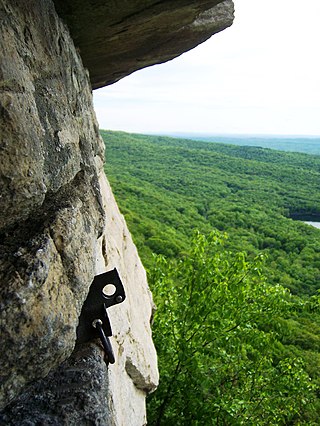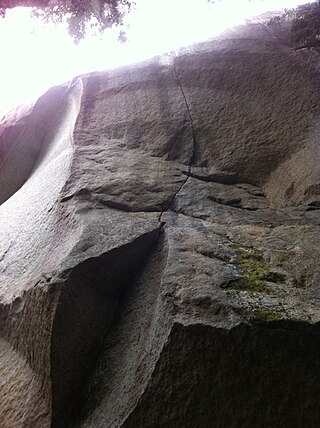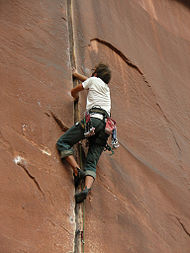
Bouldering is a form of free climbing that is performed on small rock formations or artificial rock walls without the use of ropes or harnesses. While bouldering can be done without any equipment, most climbers use climbing shoes to help secure footholds, chalk to keep their hands dry and to provide a firmer grip, and bouldering mats to prevent injuries from falls. Unlike free solo climbing, which is also performed without ropes, bouldering problems are usually less than six metres (20 ft) tall. Traverses, which are a form of boulder problem, require the climber to climb horizontally from one end to another. Artificial climbing walls allow boulderers to climb indoors in areas without natural boulders. In addition, bouldering competitions take place in both indoor and outdoor settings.

Climbing is the activity of using one's hands, feet, or other parts of the body to ascend a steep topographical object that can range from the world's tallest mountains to small boulders. Climbing is done for locomotion, sporting recreation, for competition, and is also done in trades that rely on ascension, such as rescue and military operations. Climbing is done indoors and outdoors, on natural surfaces, and on artificial surfaces

A spring-loaded camming device is a piece of rock climbing or mountaineering protection equipment. It consists of two, three, or four cams mounted on a common axle or two adjacent axles, so that pulling on the axle forces the cams to spread farther apart. This is then attached to a sling and carabiner at the end of the stem. The SLCD is used by pulling on the "trigger" so the cams retract together, then inserting it into a crack or pocket in the rock and releasing the trigger to allow the cams to expand. A pull on the rope, such as that generated by a climber falling, will cause a properly placed SLCD to convert the pulling force along the stem of the unit into outwards pressure on the rock, generating massive amounts of friction and preventing the removal of the unit from the rock. Because of the large forces which are exerted on the rock when an SLCD is fallen on, it is very important that SLCDs are only placed in solid, strong rock.

Traditional climbing is a type of free climbing in rock climbing where the lead climber places the protection equipment while ascending the route; when the lead climber has completed the route, the second climber then removes the protection equipment as they climb the route. Traditional climbing differs from sport climbing where the protection equipment is pre-drilled into the rock in the form of bolts.

Tree climbing is a recreational or functional activity consisting of ascending and moving around in the crowns of trees.

Glossary of climbing terms relates to rock climbing, mountaineering, and to ice climbing.

Rock-climbing equipment varies with the type of climbing undertaken. Bouldering needs the least equipment outside of shoes and chalk and optional crash pads. Sport climbing adds ropes, harnesses, belay devices, and quickdraws to clip into pre-drilled bolts. Traditional climbing adds the need for carrying a "rack" of temporary passive and active protection devices. Multi-pitch climbing adds devices to assist in ascending and descending fixed ropes. And finally aid climbing uses unique equipment.
Self-locking devices are devices intended to arrest the fall of solo climbers who climb without partners. This device is used for rope solo climbing, for "ground-up climbing", and for "top rope solo climbing". To date, several types of self-locking devices have evolved.

Belaying is a variety of techniques climbers use to create friction within a climbing system, particularly on a climbing rope, so that a falling climber does not fall very far. A climbing partner typically applies tension at the other end of the rope whenever the climber is not moving, and removes the tension from the rope whenever the climber needs more rope to continue climbing.

Clean climbing is rock climbing techniques and equipment which climbers use in order to avoid damage to the rock. These techniques date at least in part from the 1920s and earlier in England, but the term itself may have emerged in about 1970 during the widespread and rapid adoption in the United States and Canada of nuts, and the very similar but often larger hexes, in preference to pitons, which damage rock and are more difficult and time-consuming to install. Pitons were thus eliminated in North America as a primary means of climbing protection in a period of less than three years.

A piton in big wall climbing and in aid climbing is a metal spike that is driven into a crack or seam in the climbing surface using a climbing hammer, and which acts as an anchor for protecting the climber against the consequences of falling or to assist progress in aid climbing. Pitons are equipped with an eye hole or a ring to which a carabiner is attached; the carabiner can then be directly or indirectly connected to a climbing rope.

Rock climbing is a sport in which participants climb up, across, or down natural rock formations or indoor climbing walls. The goal is to reach the summit of a formation or the endpoint of a usually pre-defined route without falling. Rock climbing is a physically and mentally demanding sport, one that often tests a climber's strength, endurance, agility and balance along with mental control. Knowledge of proper climbing techniques and the use of specialized climbing equipment is crucial for the safe completion of routes.

Ron Kauk is an American rock climber. Kauk is associated with Camp 4 in Yosemite Valley, where he lived for decades, now a resident of El Portal, California.

Derek Geoffrey Hersey was a British rock climber who specialized in free soloing, and was for many years an active participant in the Boulder, Colorado climbing scene in the United States.
Sonnie Trotter, is a Canadian professional climber, known for his strength in many rock climbing disciplines – particularly traditional climbing – and contributing to hundreds of first free ascents around the world.
Craig Luebben was an American rock climber and author. A climber since the early 1980s, Luebben wrote a number of climbing-oriented books, and designed the Big Bro wide-crack climbing protection device–now manufactured by Trango–as part of obtaining his degree in Mechanical Engineering from Colorado State University, and was a senior contributing editor for Climbing Magazine.
Hazel Findlay is a British traditional climber, sport climber and big wall climber. She was the first female British climber to climb a route graded E9, and a route graded 8c (5.14b). She did the third ascent of the Yosemite traditional route Magic Line 5.14c (8c+). She has free climbed El Capitán four times on four different routes and made many first female ascents on other routes. Climbing magazine gave her their Golden Piton Award (Alpine) for traditional climbing in 2013.
Pete Whittaker is a British professional rock climber. He is one half of the duo known as the Wide Boyz, along with his climbing partner Tom Randall. Whittaker came to notability from crack climbing, including the first ascent of the world's hardest off-width climb, the Century Crack.
Century Crack is a 120 ft (40m) long offwidth roof crack climb in the White Rim Sandstone, Canyonlands National Park, Utah, graded at 5.14b (8c). It is one of the hardest and longest offwidth crack climbs in the world. The first aid ascent of the route was done by Steve Bartlett in 2001, and the first free ascents were by crack specialists Pete Whittaker and Tom Randall, known as the Wide Boyz.

Cobra Crack is a 45-metre (148 ft) long traditional climbing route on a thin crack up an overhanging granite rock face on Stawamus Chief, in Squamish, British Columbia. The route was first ascended by Peter Croft and Tami Knight in 1981 as an aid climb. After rebuffing many attempts by leading climbers – most notably by Swiss crack climber Didier Berthod in 2005 – Canadian climber Sonnie Trotter made the first free ascent in 2006. With subsequent ascents, the consensus grade has settled at 5.14b (8c) which ranked Cobra Crack as one of the hardest crack climbs in the world, and almost two decades later, it is still considered one of the world's hardest traditional climbing routes.
















